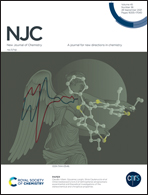Theoretical study on the sensing mechanism of chalcone-based fluorescence probe for detecting hydrogen sulfide and biothiols†
Abstract
A fluorescent probe 2′-(2,4-dinitro-phenoxy)-4-(dimethylamino) chalcone (Pr1, Spectrochim. Acta, Part A 2021, 244, 118839) based on twisted intramolecular charge transfer (TICT) and excited state intramolecular proton transfer (ESIPT) was designed and synthesized recently for the detection of H2S and biothiols in aqueous solutions and cells. Along with the single fluorescence phenomenon in the experiment, it is worth analyzing whether the ESIPT process emerges, and the detailed sensing mechanism of Pr1 as a fluorescence probe needs to be explored in depth. Herein, density functional theory (DFT) and time-dependent density functional theory (TD-DFT) methods were exploited to investigate the geometric structures and fluorescence properties for Pr1 and its product 2′-hydroxy-4-(dimethylamino) chalcone (Comp2) after adding H2S/biothiols. The geometrical structure parameters, reduced density gradient (RDG) analysis and infrared vibrations associated with the hydrogen bond for Comp2 indicate that the intramolecular hydrogen bond is strengthened upon photo-excitation compared with the S0 state, and the existence of the ESIPT process was confirmed by the potential energy curve. In addition, the results of hole–electron analysis and frontier molecular orbitals explained the inducement of fluorescence quenching for Pr1 and the mechanism of fluorescence emission for Comp2. In consequence, the phenomenon of a single fluorescence peak for the ESIPT-based active dye Comp2 in experiments is expounded by the Boltzmann distribution, which provides a theoretical reference for the development of novel fluorescent probes.



 Please wait while we load your content...
Please wait while we load your content...